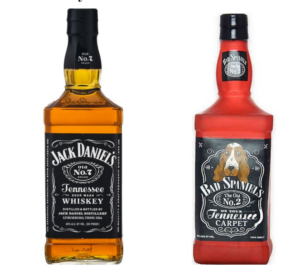1300 19th Street, N.W.
Suite 420 Washington, DC 20036
Jack Daniel’s v. VIP Products: 3 Takeaways from the Supreme Court Decision
By Rob Litowitz and Brianna Christenson
Trademark gurus and First Amendment mavens had been waiting for the Supreme Court to decide a case with potentially profound implications for both camps, Jack Daniel’s v. VIP Products.

The issue before the Court was both straightforward and nuanced: Jack Daniel’s has strong trademark rights in its name, bottle shape, logo, and slogans–icons all. But does VIP’s Bad Spaniel’s Old No. 2 dog toy, which, depending on one’s perspective is either harmless canine potty humor or an outright rip-off of Jack Daniel’s goodwill, enjoy special First Amendment protection as an expressive work, pushing the traditional “likelihood of confusion” test for trademark infringement aside?
We now have the Supreme Court’s answer. Here’s what you need to know.
1. The Rogers Test Lives On For Expressive Works
VIP argued that a special threshold requirement, known as the Rogers test, applied because its product—clearly a parody—deserved the same Constitutional safe harbor as film titles and other expressive works. (The Rogers case involved the film title “Fred and Ginger” for a movie about two aged dancers who fancied themselves like the legendary dance team Fred Astaire and Ginger Rogers. Ms. Rogers objected to her name being on movie marquees. The Second Circuit ruled that the First Amendment’s protection for expressive works trumped Ms. Roger’s concerns.)
Some observers worried that the Supreme Court might strike down or limit Rogers. It did not. It simply ruled that Rogers did not apply here. See below.
2. The Rogers Test Does Not Apply To Trademarks Used as Trademarks, No Matter How Funny, Clever, or Bawdy
Justice Kagan’s Opinion laid out a bright-line rule: There is no First Amendment threshold test where “an alleged infringer uses a trademark in the way the Lanham Act most cares about: as a designation of source for the infringer’s own goods.” That is exactly what VIP did, according to the Court, making this a straight-up case of trademark infringement and dilution.
3. Jokes and expressions still matter.
The Lanham Act isn’t humorless. As the Court noted “a trademark’s expressive message—particularly a [parody]—may properly figure in assessing the likelihood of confusion.” The Court thus threw a bone to VIP and other would be commercial parodists by signaling to the lower courts that they should take jokes seriously because where the message of “ridicule” or “pointed humor” is clear, “a parody is not likely to create confusion.”
In short, VIP no longer can rely on the First Amendment to deflect Jack Daniel’s trademark claims. But Jack Daniel’s still must prove a likelihood of confusion and dilution. It must prove that Bad Spaniel’s Old No. 2 dog toy confuses, not amuses.
Thank you!
Thank you for getting in touch!
We appreciate you contacting us. One of our colleagues will get back in touch with you soon!
Your cookies settings
XThis website stores cookies on your computer. These cookies are used to collect information about how you interact with our website and allow us to remember you. We use this information in order to improve and customize your browsing experience and for analytics and metrics about our visitors both on this website and other media. To find out more about the cookies we use, see our Privacy Policy.
More infoI Agree

